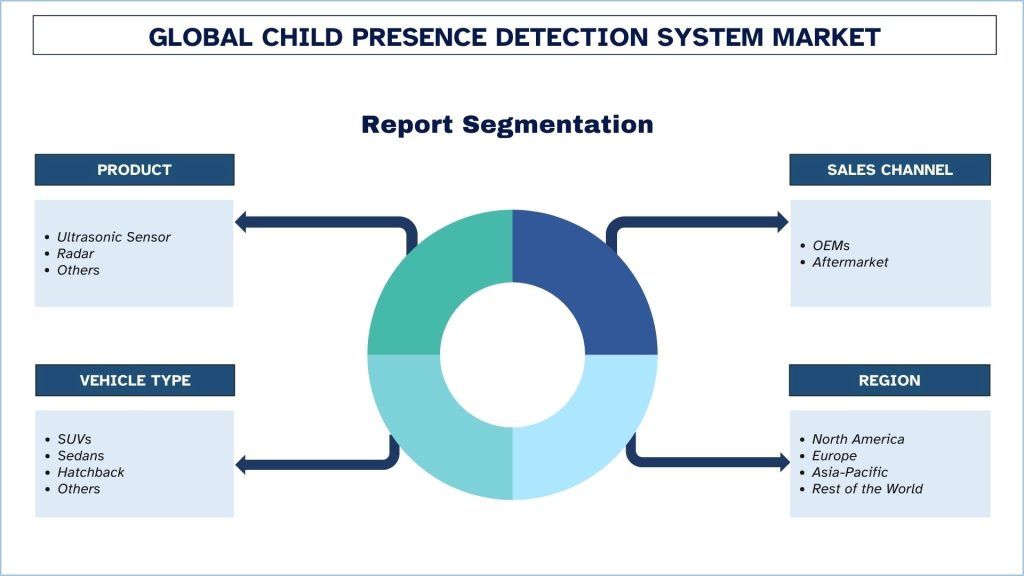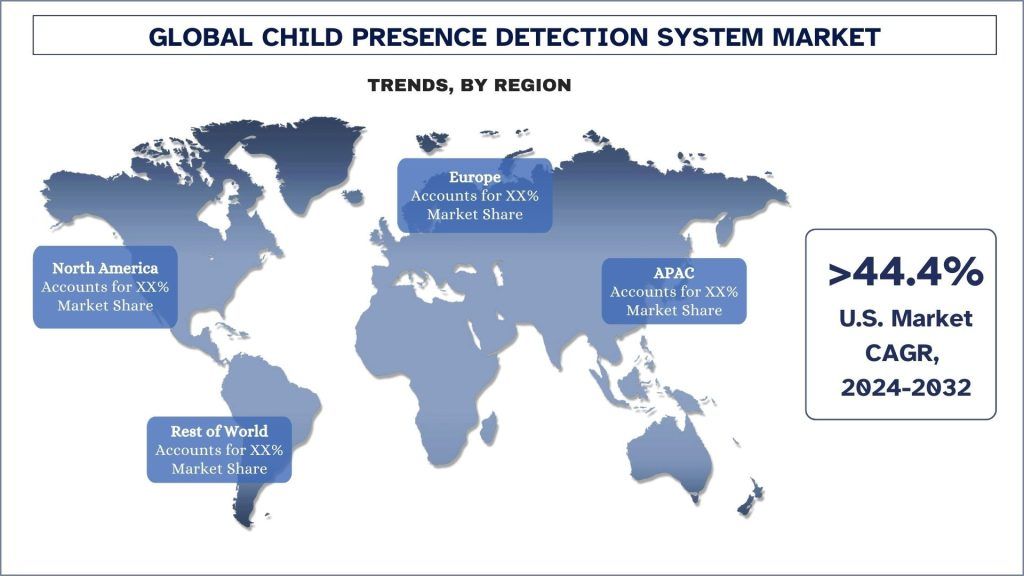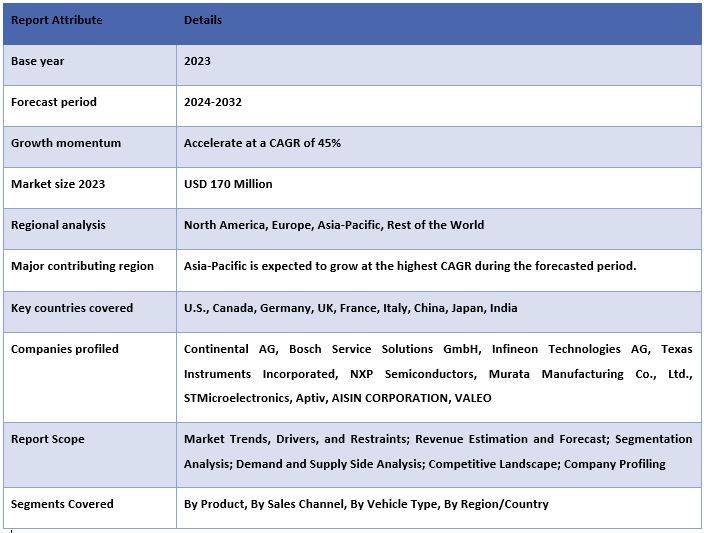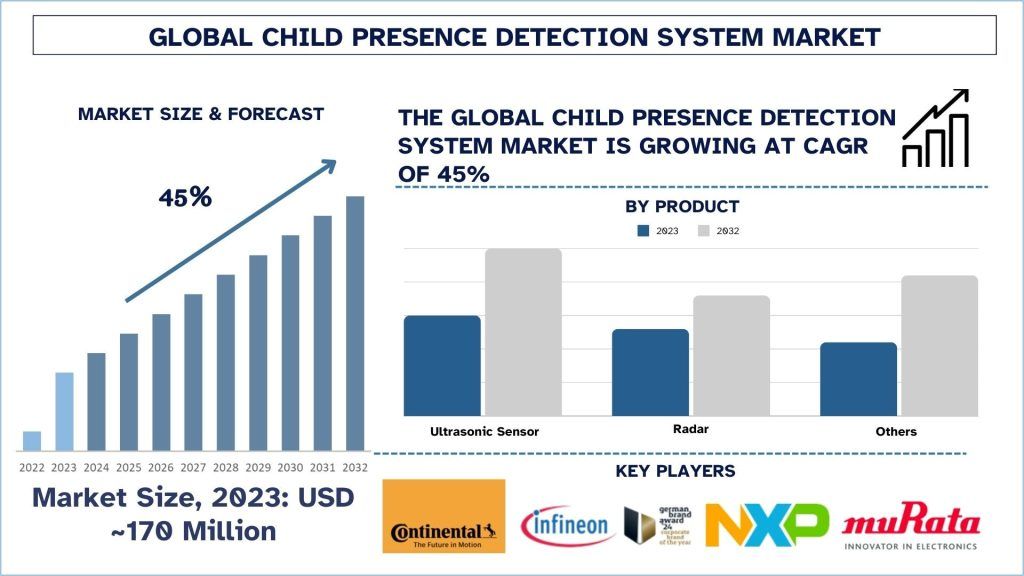Child Presence Detection System Market: Current Analysis and Forecast (2024-2032)
Emphasis on Product (Ultrasonic, Radar, and Others); Sales Channel (OEMs and Aftermarket); and Vehicle Type (SUVs, Sedans, Hatchback, and Others); and Region/Country
Child Presence Detection System Market Size & Forecast
The Child Presence Detection System Market was valued at approximately USD 170 Million in 2023 and is expected to grow at a substantial CAGR of around 45% during the forecast period (2024-2032) owing to the increasing regulations mandating child presence detection systems.
Child Presence Detection System Market Analysis
A Child Presence Detection (CPD) System is an enhanced safety feature meant to identify the absence of a child in a vehicle while he or she is still inside. These systems employ devices like radar, ultrasonic or video to detect motion or the existence of a child in the back seat. The current CPD systems notify the driver through visual or audio reminder alert or a notification received on the mobile phone to avoid heatstroke or other risks that may occur due to leaving a child in the car by default. Moreover, several countries are also adopting legislation to require the incorporation of CPD systems into new vehicle models, thus contributing to the fast growth of the market.
This sector enables modern technologies that manufacturers of CPD systems integrate include radar, infrared, and AI algorithms. For instance, In April 2023, Technology company Continental expanded its digital access system CoSmA by a Child-Presence-Detection function (CPD) for even more passenger safety. When the outdoor temperatures reach 30 degrees Celsius, in-car temperatures can reach up to 45 degrees within half an hour. They are also developing strategic alliances with automobile makers to have such systems incorporated into the automobiles during assembly. Furthermore, there is increased concern about meeting safety standards so as to meet the increasing market demand especially U.S and European markets.
Child Presence Detection System Market Trends
This section discusses the key market trends influencing the various segments of the child presence detection system market as identified by our research experts.
Radar Transforms Child Presence Detection System Industry
The Radar segment has the most significant impact on the growth of the child presence detection system industry because of its function of detecting movement or presence even through objects that are not metallic such as seats. Radar sensors work in the Millimeter Wave band which offers capability of sensing even the movements as small as a child breathing. Moreover, radar sensors are highly effective in detecting children who could be asleep or physically inactive. For instance, on November 28, 2023, NXP Semiconductors announced the Trimension NCJ29D6, a fully integrated automotive single-chip Ultra-Wideband (UWB) family combining next-generation secure and precise real-time localization with short-range radar to address multiple use cases with a single system, including secure car access, child presence detection, intrusion alert, gesture recognition and more. Radar based CPD systems are becoming popular because they are more accurate than camera and ultrasonic systems, can work under varying conditions of light and environment, and are not inflicted on the vehicle.
North America leads the market.
North America holds the largest share in the market of Child Presence Detection (CPD) system caused by strict safety norms and increasing awareness of child endangerment in vehicles. As per the Kids and Car Safety organization, in 2023, The average number of U.S. child hot car deaths is 29 per year. For instance, the US has legislated on the automaker’s use of CPD systems by passing legislation such as the Hot Cars Act that seeks to require all automobiles manufactured from now onwards to come with these systems to help avoid heat stroke deaths as a result of children being left alone in cars. Hot Cars Act of 2021 Bill: To require the Secretary of Transportation to issue a rule that requires all new passenger motor vehicles to be equipped with a child safety alert system, and for other purposes. In the region there is a strong automotive industry with high consumer demand for advanced safety features for their automobiles compelling auto makers to include CPD systems in their models. Also, synergy between tech suppliers and automotive original equipment manufacturers, systems based on radar and artificial intelligence are driving the North America market.

Child Presence Detection System Industry Overview
The Child Presence Detection System market is competitive, with several global and international players. The key players are adopting different growth strategies to enhance their market presence, such as partnerships, agreements, collaborations, new product launches, geographical expansions, and mergers and acquisitions. Some of the major players operating in the market are Continental AG, Bosch Service Solutions GmbH, Infineon Technologies AG, Texas Instruments Incorporated, NXP Semiconductors, Murata Manufacturing Co., Ltd., STMicroelectronics, Aptiv, AISIN CORPORATION, VALEO.

Child Presence Detection System Market News
For instance, In July 2024, Origin AI successfully commercialized a revolutionary in-vehicle Child Presence Detection (CPD) system with Murata Manufacturing Co., Ltd. utilizing Origin AI’s Wi-Fi Sensing technology. The product’s first application was successfully deployed on a Japanese school bus and will be operated to prevent children from being left behind in the future.
In March 2024, the international automotive supplier FORVIA HELLA expanded its market position in the field of digital access systems with additional customer orders. Series production will start in Romania and Mexico in 2025; in this context, FORVIA HELLA will also bring the NCAP-relevant safety function “Child Presence Detection” based on ultra-wideband technology onto the streets for the first time.
On March 8, 2023, Continental expanded its digital access system (CoSmA) with a Child-Presence-Detection function (CPD) to take passenger safety and comfort to the next level. CPD detects and classifies left-behind children inside the vehicle within seconds and triggers an audible, visual or haptic warning to alarm the driver. The CPD function is seamlessly integrated into Continental’s CoSmA UWB Digital Access solution, making additional hardware redundant while resulting in overall system cost savings and simplification. It enables vehicle manufacturers to meet upcoming in-cabin safety targets of Euro NCAP and US regulations.
Child Presence Detection System Market Report Coverage

Reasons to buy this report:
- The study includes market sizing and forecasting analysis validated by authenticated key industry experts.
- The report presents a quick review of overall industry performance at one glance.
- The report covers an in-depth analysis of prominent industry peers with a primary focus on key business financials, product portfolios, expansion strategies, and recent developments.
- Detailed examination of drivers, restraints, key trends, and opportunities prevailing in the industry.
- The study comprehensively covers the market across different segments.
- Deep dive regional level analysis of the industry.
Customization Options:
The global child presence detection system market can be customized further as per the requirement or any other market segment. Besides this, UMI understands that you may have your own business needs, hence feel free to connect with us to get a report that completely suits your requirements.
Table of Contents
Research Methodology for the Child Presence Detection System Market Analysis (2022-2032)
Analyzing the historical market, estimating the current market, and forecasting the future market of the global Child Presence Detection System market were the three major steps undertaken to create and analyze the adoption of Child Presence Detection System in major regions globally. Exhaustive secondary research was conducted to collect the historical market numbers and estimate the current market size. Secondly, to validate these insights, numerous findings and assumptions were taken into consideration. Moreover, exhaustive primary interviews were also conducted, with industry experts across the value chain of the global Child Presence Detection System market. Post assumption and validation of market numbers through primary interviews, we employed a top-down/bottom-up approach to forecasting the complete market size. Thereafter, market breakdown and data triangulation methods were adopted to estimate and analyze the market size of segments and sub-segments of the industry. Detailed methodology is explained below:
Analysis of Historical Market Size
Step 1: In-Depth Study of Secondary Sources:
A detailed secondary study was conducted to obtain the historical market size of the Child Presence Detection System market through company internal sources such as annual reports & financial statements, performance presentations, press releases, etc., and external sources including journals, news & articles, government publications, competitor publications, sector reports, third-party database, and other credible publications.
Step 2: Market Segmentation:
After obtaining the historical market size of the Child Presence Detection System market, we conducted a detailed secondary analysis to gather historical market insights and share for different segments & sub-segments for major regions. Major segments are included in the report as product, sales channel, vehicle type, and regions. Further country-level analyses were conducted to evaluate the overall adoption of testing models in that region.
Step 3: Factor Analysis:
After acquiring the historical market size of different segments and sub-segments, we conducted a detailed factor analysis to estimate the current market size of the Child Presence Detection System market. Further, we conducted factor analysis using dependent and independent variables such as product, sales channel, vehicle type, and regions of the Child Presence Detection System market. A thorough analysis was conducted for demand and supply-side scenarios considering top partnerships, mergers and acquisitions, business expansion, and product launches in the Child Presence Detection System market sector across the globe.
Current Market Size Estimate & Forecast
Current Market Sizing: Based on actionable insights from the above 3 steps, we arrived at the current market size, key players in the global Child Presence Detection System market, and market shares of the segments. All the required percentage shares split and market breakdowns were determined using the above-mentioned secondary approach and were verified through primary interviews.
Estimation & Forecasting: For market estimation and forecast, weights were assigned to different factors including drivers & trends, restraints, and opportunities available for the stakeholders. After analyzing these factors, relevant forecasting techniques i.e., the top-down/bottom-up approach were applied to arrive at the market forecast for 2032 for different segments and sub-segments across the major markets globally. The research methodology adopted to estimate the market size encompasses:
- The industry’s market size, in terms of revenue (USD) and the adoption rate of the Child Presence Detection System market across the major markets domestically
- All percentage shares, splits, and breakdowns of market segments and sub-segments
- Key players in the global Child Presence Detection System market in terms of products offered. Also, the growth strategies adopted by these players to compete in the fast-growing market
Market Size and Share Validation
Primary Research: In-depth interviews were conducted with the Key Opinion Leaders (KOLs) including Top Level Executives (CXO/VPs, Sales Head, Marketing Head, Operational Head, Regional Head, Country Head, etc.) across major regions. Primary research findings were then summarized, and statistical analysis was performed to prove the stated hypothesis. Inputs from primary research were consolidated with secondary findings, hence turning information into actionable insights.
Split of Primary Participants in Different Regions

Market Engineering
The data triangulation technique was employed to complete the overall market estimation and to arrive at precise statistical numbers for each segment and sub-segment of the global Child Presence Detection System market. Data was split into several segments and sub-segments after studying various parameters and trends in the product, sales channel, vehicle type, and regions of the global Child Presence Detection System market.
The main objective of the Global Child Presence Detection System Market Study
The current & future market trends of the global Child Presence Detection System market were pinpointed in the study. Investors can gain strategic insights to base their discretion for investments on the qualitative and quantitative analysis performed in the study. Current and future market trends determined the overall attractiveness of the market at a regional level, providing a platform for the industrial participant to exploit the untapped market to benefit from a first-mover advantage. Other quantitative goals of the studies include:
- Analyze the current and forecast market size of the Child Presence Detection System market in terms of value (USD). Also, analyze the current and forecast market size of different segments and sub-segments.
- Segments in the study include areas of the product, sales channel, vehicle type, and regions.
- Define and analyze the regulatory framework for the Child Presence Detection System
- Analyze the value chain involved with the presence of various intermediaries, along with analyzing customer and competitor behaviors of the industry.
- Analyze the current and forecast market size of the Child Presence Detection System market for the major region.
- Major countries of regions studied in the report include Asia Pacific, Europe, North America, and the Rest of the World
- Company profiles of the Child Presence Detection System market and the growth strategies adopted by the market players to sustain the fast-growing market.
- Deep dive regional level analysis of the industry
Frequently Asked Questions FAQs
Q1: What is the Child Presence Detection System market's current size and growth potential?
Q2: What are the driving factors for the growth of the Child Presence Detection System market?
Q3: Which segment has the largest share of the Child Presence Detection System market by product?
Q4: What are the major trends in the Child Presence Detection System market?
Q5: Which region will dominate the Child Presence Detection System market?
Related Reports
Customers who bought this item also bought











